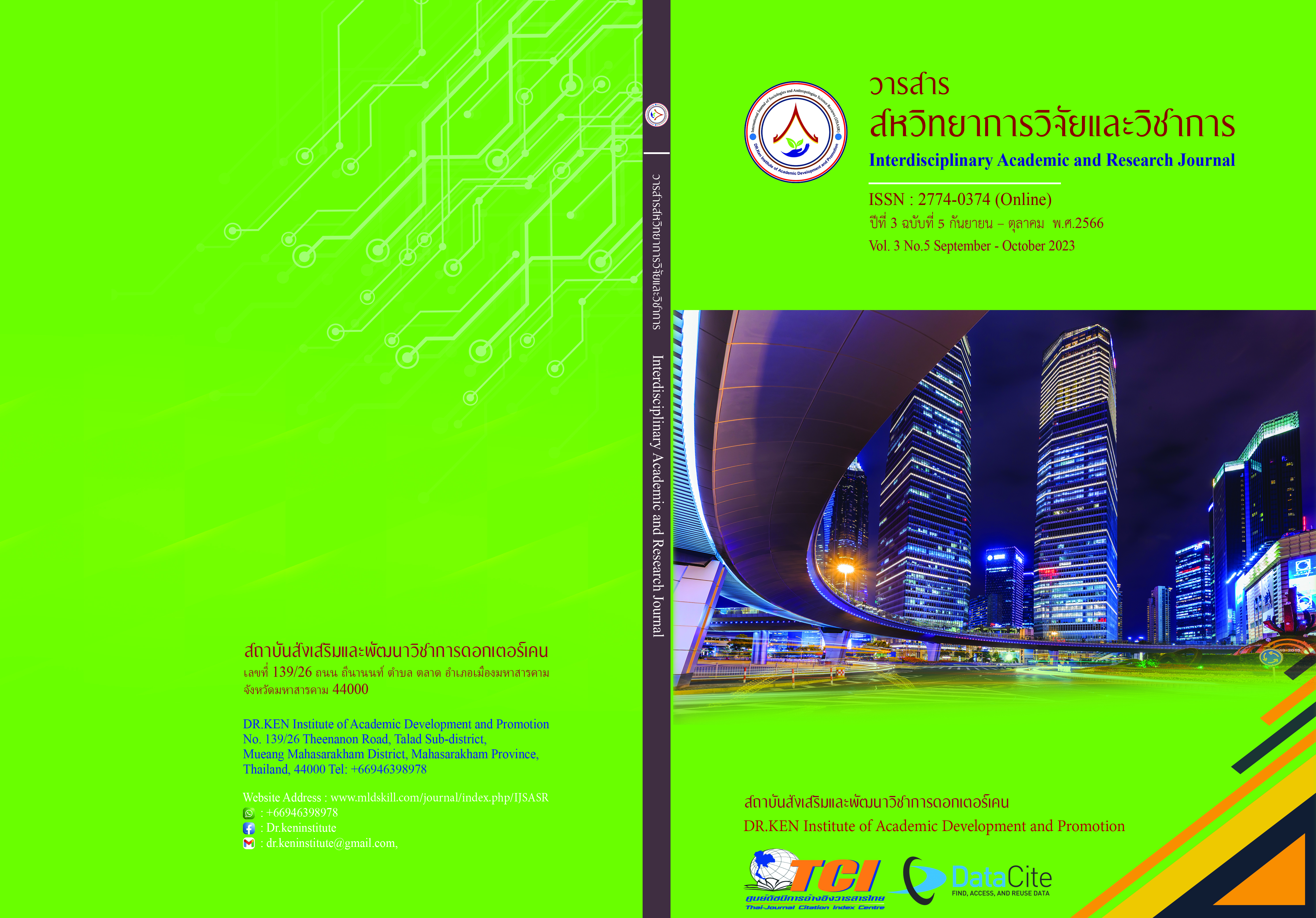The Project-Based Learning on Electrochemistry to Promote Creative Thinking and Learning Achievement of Grade 11 Students
DOI:
https://doi.org/10.14456/iarj.2023.256Keywords:
Project-Based Learning; , Creative Thinking; , Learning AchievementAbstract
Current education management science and technology are very important. Cultivating and transferring knowledge of science appropriate to their potential and aptitude. It is therefore important to equip students with the knowledge and skills needed in the 21st century. The objectives of this research were to (1) compare the creative thinking of grade 11 students before and after the project-based learning and (2) compare learning achievement on Electrochemistry of grade 11 students before and after the project-based learning. The sample group consisted of 38 secondary students at grade 11, from Anukoolnaree school in the second semester of the academic year 2022. The Cluster Random Sampling technique was implemented for the sampling. Research instruments included (1) the project-based learning lesson plans for 20 hours, (2) the 5 items written tests of creative thinking, and (3) the 30 items of four multiple-choice achievement tests on Electrochemistry. The data analysis statistics were mean, standard deviation), and t–tests for the Dependent Sample. The result found that (1) Grade 11 students had creative thinking scores after the project-based learning higher than before the learning at a .05 statistical significance level. When considering each aspect, it was found that after the project-based learning, students had the highest creative thinking in Fluency, followed by Flexibility, Originality, and Elaboration, respectively and (2) Grade 11 students had higher learning achievement after the project-based learning higher than before the learning at a .05 statistical significance level.
References
กรุงเทพธุรกิจ. (2565). ดัชนีนวัตกรรมโลกปี 2565. Retrieved on 12 March 2023, from: https://www.bangkokbiznews.com/tech/innovation/1029783
จริยา พิชัยคำ. (2559). ทักษะการเรียนรู้และนวัตกรรมพัฒนาได้ด้วยการจัดการเรียนรู้แบบโครงงานเป็นฐาน.วารสารวิชาการ มหาวิทยาลัยราชภัฏอุตรดิตถ์, 11(1), 2-12.
จารุณี มนปราณีต. (2561). ความคิดเห็นต่อการจัดการเรียนรู้ตามนโยบายไทยแลนด์ 4.0 ด้วยรูปแบบโครงงานเป็นฐานในชั้นเรียนวิทยาศาสตร์ที่เอื้อต่อความคิดสร้างสรรค์ของนักเรียนชั้นมัธยมศึกษาตอนต้น สังกัดสำนักงานเขตพื้นที่การศึกษามัธยมศึกษา เขต 27. วิทยานิพนธ์ปริญญามหาบัณฑิต สาขาวิทยาศาสตรศึกษา: มหาวิทยาลัยราชภัฏมหาสารคาม.
จินตนา รุ่งเรือง. (2557). การใช้ชุดกิจกรรมฝึกทำโครงงานวิทยาศาสตร์ที่มีต่อผลสัมฤทธิ์ทางการเรียนโครงงานวิทยาศาสตร์และความคิดสร้างสรรค์ทางวิทยาศาสตร์ของนักเรียนชั้นมัธยมศึกษาปีที่ 1 กลุ่มโรงเรียนขยายโอกาส สำนักงานเขตภาษีเจริญ กรุงเทพมหานคร. Electronic Journal of Open and Distance Innovative Learning, 4(2), 75-87.
ชนินันท์ พฤกษ์ประมูล. (2557). การประเมินทักษะกระบวนการทางวิทยาศาสตร์. วารสารสุทธิปริทัศน์, 28(86), 352-364.
ชัยวัฒน์ สุทธิรัตน์. (2553). 80 นวัตกรรมการจัดการเรียนรู้ที่เน้นผู้เรียนเป็นสำคัญ. พิมพ์ครั้งที่ 3. กรุงเทพฯ: แดเน็กซ์ อินเตอร์
ชูกิจ ลิมปิจำนงค์. (2562). แผนปฏิบัติการเชิงกลยุทธ์ สถาบันส่งเสริมการสอนวิทยาศาสตร์และเทคโนโลยีประจำปีงบประมาณ พ.ศ. 2562-2564. Retrieved March 12, 2023, from: https://www.ipst. ac.th/wpcontent/uploads/2020/10/StrategicPlan62-64.pdf
ณัฐกานต์ ภูมิคอนสาร. (2564). ทักษะความคิดสร้างสรรค์ที่หล่นหายไปของผู้เรียนกับการศึกษาในศตวรรษที่ 21. Education Journal, 5(1), 1-9.
ดนชนก เบื่อน้อย. (2559). นวัตกรรมกับความคิดสร้างสรรค์. วารสารวิชาการการตลาดและการจัดการ มหาวิทยาลัยเทคโนโลยีราชมงคลธัญบุรี, 3(1), 1-12.
ดุษฎี โยเหลา. (2557). การศึกษาการจัดการเรียนรู้แบบ PBL ที่ได้จากโครงการสร้างชุดความรู้เพื่อสร้างเสริมทักษะแห่งศตวรรษที่ 21 ของเด็กและเยาวชน: จากประสบการณ์ความสำเร็จของโรงเรียนไทย. กรุงเทพฯ: ทิพยวิสุทธิ์.
ธันยวิช วิเชียรพันธ์. (2561). คู่มือการจัดการเรียนรู้ เพื่อเสริมสร้างทักษะการคิดวิเคราะห์และสร้างสรรค์แก่ผู้เรียน. Retrieved on 1 January 2022, from: http://www.lertchaimaster.com /doc/Learning-Management-Guide-Thinking-Skills.pdf
ประสาท เนืองเฉลิม. (2558). การเรียนรู้วิทยาศาสตร์ในศตวรรษที่ 21. กรุงเทพฯ: จุฬาลงกรณ์มหาวิทยาลัย.
ปิณิดา สุวรรณพรม. (2563). การเปรียบเทียบความคิดสร้างสรรค์ทางวิทยาศาสตร์และผลสัมฤทธิ์ทางการเรียน เรื่อง การถ่ายโอนพลังงานความร้อน กลุ่มสาระการเรียนรู้วิทยาศาสตร์ของนักเรียนชั้นมัธยมศึกษาปีที่ 1 ที่ได้รับการจัดกิจกรรมการเรียนรู้แบบโครงงานเป็นฐานและแบบโครงงานเป็นฐานตามแนวทางสะเต็มศึกษา. วารสารรำไพพรรณี, 14(3), 52-62.
พิมพันธ์ เดชะคุปต์ และพเยาว์ ยินดีสุข. (2548). วิธีวิทยาการสอนวิทยาศาสตร์ทั่วไป. กรุงเทพฯ: สำนักพิมพ์ บริษัทพัฒนาคุณภาพวิชาการ.
ภิณโญ วงษ์ทอง และวันชัย น้อยวงค์. (2563). พฤติกรรมบ่งชี้ 4Cs ที่จำเป็นของผู้เรียนในศตวรรษที่ 21: การทบทวนวรรณกรรมอย่างกระชับ. วารสารมนุษยศาสตร์และสังคมศาสตร์มหาวิทยาลัยธนบุรี, 15(2), 176-186.
โรงเรียนอนุกูลนารี. (2565). ข้อมูลจำนวนนักเรียนโรงเรียนอนุกูลนารี. กาฬสินธุ์: โรงเรียนอนุกูลนารี อำเภอเมือง จังหวัดกาฬสินธุ์
ลัดดา ภู่เกียรติ. (2552). การสอนแบบโครงงานและการสอนแบบใช้วิจัยเป็นฐาน: งานที่ครูประถมทำได้. กรุงเทพฯ: สาฮะแอนด์ซันพริ้นติ้ง.
ลัดดา ศิลาน้อย และอังคณา ตุงคะสมิต. (2556). ยกระดับครูสังคมศึกษาสู่ประชาคมอาเซียน (ASEAN Community) ด้วยกระบวนการจัดการเรียนรู้ในศตวรรษที่ 21. ขอนแก่น: มหาวิทยาลัยขอนแก่น.
ลุฏฟี ดอเลาะ. (2560). การจัดการเรียนรู้แบบโครงงานที่มีต่อผลสัมฤทธิ์ทางการเรียนชีววิทยา ทักษะกระบวนการทางวิทยาศาสตร์และเจตคติต่อวิทยาศาสตร์ของนักเรียนชั้นมัธยมศึกษาปีที่ 5. วิทยานิพนธ์ปริญญามหาบัณฑิต สาขาวิชาการสอนวิทยาศาสตร์และคณิตศาสตร์: มหาวิทยาลัยสงขลานครินทร์.
วิจารณ์ พานิช. (2555). วิถีการสร้างการเรียนรู้เพื่อศิษย์ในศตวรรษที่ 21. กรุงเทพฯ: มูลนิธิสดศรีสฤษดิ์วงศ์.
สถาบันทดสอบทางการศึกษาแห่งชาติ. (2562). ผลการทดสอบทางการศึกษาระดับชาติขั้นพื้นฐาน (O-NET) ของนักเรียนชั้น มัธยมศึกษาปีที่ 6. Retrieved on 1 January 2022, from: http://www.newonet result.niets.or.th/AnnouncementWeb/Notice/FrBasicStat.aspx
สำนักงานคณะกรรมการการอาชีวศึกษา. (2559). แนวทางการจัดการเรียนรู้แบบโครงงานเป็นฐาน (พิมพ์ครั้งที่ 2). นครปฐม: สินทวีกิจ พริ้นติ้ง.
สุธินี แจ่มอุทัย. (2559). PBL แรงกระตุ้นและเป้าหมายของการเรียนภาษาอังกฤษ. นครสวรรค์: มหาวิทยาลัยราชภัฏนครสรรค์.
อรสาร จรูญธรรม. (2563). ผลของการจัดการเรียนการสอนโดยใช้โครงงานเป็นฐานที่มีต่อผลสัมฤทธิ์ทางการเรียนวิชา วิทยาศาสตร์และความสามารถในการแก้ปัญหาของนักเรียนชั้นมัธยมศึกษาตอนต้น. วารสารสถาบันวิจัยและพัฒนา มหาวิทยาลัยราชภัฎมหาสารคาม, 7(1), 226-240.
Baron, K. (2010). Six Steps for Planning a Successful Project. Retrieved 20 September 2021, from: https://www.edutopia.org/stw-maine-project-based-learning-six-steps-planning
Best, J.W. (1981). Research in Education. 4th edition. New Jersey: Prentice Hall.
Guilford, J.P. (1969). Fundamental Statistics in Psychology and Education. New York: McGraw-Hill.
Hallman, & Ralph J. (1971). “Techniques of Creation Techniques of Creative Teaching” Teaching Creation Thinking. New York: Holt, Rinehart, and Winston.
Klopfer, L.E. (1971). Evaluation of Learning in Science. New York: McGraw-Hill.
Putri, N.L.P.N.S., Artini, L. P., & Nitiasih, P.K. (2017). Project-Based Learning Activities and EFL Students' Productive Skills in English. Journal of Language Teaching and Research, 8(6), 1147-1155.
Downloads
Published
How to Cite
Issue
Section
License
Copyright (c) 2023 Sasima Nongsook, Panwilai Dokmai

This work is licensed under a Creative Commons Attribution-NonCommercial-NoDerivatives 4.0 International License.
Copyright on any article in the Interdisciplinary Academic and Research Journal is retained by the author(s) under the under the Creative Commons Attribution-NonCommercial-NoDerivatives 4.0 International License. Permission to use text, content, images, etc. of publication. Any user to read, download, copy, distribute, print, search, or link to the full texts of articles, crawl them for indexing, pass them as data to software, or use them for any other lawful purpose. But do not use it for commercial use or with the intent to benefit any business.
















.png)


